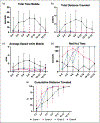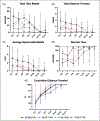Optimization of overhead enclosure monitoring in juvenile male Dunkin Hartley guinea pigs (Cavia porcellus)
- PMID: 37070354
- PMCID: PMC11141528
- DOI: 10.1177/00236772231165810
Optimization of overhead enclosure monitoring in juvenile male Dunkin Hartley guinea pigs (Cavia porcellus)
Abstract
Overhead enclosure monitoring provides objective quantitative mobility measurements for animals undergoing open-field testing. Notably, protocols for testing optimization have been minimally established for the guinea pig. It is unknown whether (a) repeated exposure, (b) time-of-day, or (c) length of testing duration influence outcome parameters. We hypothesized that guinea pigs would display decreased activity following repeated exposure to the open field; heightened activity during the earliest testing period; and that 10 min would be adequate for data collection. The study was conducted in two separate phases to distinguish between enclosure habituation and time-of-day effects, respectively. Two cohorts of male Dunkin Hartley guinea pigs were allowed voluntary movement in an open-field enclosure for 14 min to quantify mobility outcomes, including total distance traveled, total time mobile, average speed while mobile, and total time spent in the shelter. For both phases, testing occurred at four different times of day, and overhead monitoring software was programmed to divide the total testing duration into 2-min bins. Habituation phase results showed time mobile and distance traveled were influenced significantly by repeat exposure, as animals were most active during the first testing event. Time-of-day phase animals spent significantly more time mobile during the earliest testing period. Interestingly, significant differences were observed across 2-min bins for the time-of-day phase but not during the habituation phase. Specifically, progressively decreased ambulatory activity was observed as testing duration increased. Thus, habituation and time-of-day should be accounted for when possible. Finally, a trial period greater than 10 min may not yield additional data.
La surveillance aérienne fournit des mesures quantitatives objectives de la mobilité des animaux soumis à des tests en champ ouvert. Il n’existe que peu de protocoles d’optimisation des tests menés sur le cobaye. On ne sait pas si (i) une exposition répétée, (ii) l’heure ou (iii) la durée des tests influencent les paramètres de résultats. Nous avons émis l’hypothèse que les cobayes seraient atteints d’une diminution de l’activité suite à une exposition répétée au champ ouvert; d’une augmentation de l’activité au cours de la première période d’essai; et que 10 minutes seraient adéquates pour la collecte des données. L’étude a été menée en deux phases distinctes pour distinguer l’accoutumance à l’enceinte et les effets de l’heure du jour, respectivement. Deux cohortes de cobayes Dunkin Hartley maˆles ont été autorisées à se déplacer librement dans une enceinte à champ ouvert pendant 14 minutes afin de quantifier les résultats de mobilité, notamment la distance totale parcourue, le temps total de déplacement, la vitesse moyenne de déplacement et le temps total passé dans l’abri. Les tests ont eu lieu à quatre moments différents de la journée dans les deux phases, et un logiciel de surveillance aérienne a été programmé pour diviser la durée totale des tests en bacs de 2 minutes. Les résultats de la phase d’accoutumance ont montré que le temps de déplacement et la distance parcourue étaient significativement influencés par une exposition répétée, car les animaux étaient les plus actifs au cours du premier événement d’essai. Les animaux de la phase des heures de la journée ont passé beaucoup plus de temps à se déplacer pendant la première période d’essai. Il est intéressant de noter que des différences significatives ont été observées dans les bacs de 2 minutes pour la phase des heures de la journée, mais pas pendant la phase d’accoutumance. Plus précisément, une diminution progressive de l’activité ambulatoire a été observée à mesure que la durée des tests augmentait. L’accoutumance et l’heure du jour doivent donc être prises en compte lorsque cela est possible. Enfin, une période d’essai supérieure à 10 minutes peut ne pas fournir de données supplémentaires.
Die Beobachtung im freien Gelände bietet objektive quantitative Messungen von Bewegungsaktivitäten im Rahmen von Tierversuchen im Open-Field-Test. Speziell für Meerschweinchen wurden bisher nur wenige Protokolle zur Optimierung der Tests erstellt. Es ist nicht bekannt, ob (i) die wiederholte Exposition, (ii) die Tageszeit oder (iii) die Länge der Testdauer die Ergebnisparameter beeinflussen. Wir gingen von der Hypothese aus, dass die Aktivität von Meerschweinchen nach wiederholter Open Field-Exposition abnimmt, dass die Aktivität während der frühesten Testperiode erhöht ist und dass 10 Minuten für die Datenerfassung ausreichend sind. Die Studie wurde in zwei getrennten Phasen durchgeführt, um jeweils zwischen Gewöhnung an das Gelände und tageszeitlichen Effekten zu unterscheiden. Zwei Kohorten männlicher Dunkin-Hartley-Meerschweinchen konnten sich 14 Minuten lang beliebig in einem Freigelände bewegen, um die Bewegungsergebnisse zu quantifizieren, einschlieβlich der zurückgelegten Gesamtstrecke, der Gesamtbewegungszeit, der Durchschnittsgeschwindigkeit während der Bewegung und der im Gehege verbrachten Gesamtzeit. In beiden Phasen fanden die Tests jeweils zu vier verschiedenen Tageszeiten statt, und die gesamte Testdauer wurde durch Überwachungssoftware programmiert und in 2-Minuten-Schritte unter-teilt. Die Ergebnisse der Gewöhnungsphase zeigten, dass die Bewegungszeit der Tiere und die zurückgelegte Strecke signifikant von der wiederholten Exposition beeinflusst wurden, da die Tiere während des ersten Testvorgangs am aktivsten waren. Die Tiere der Tageszeit-Phase verbrachten signifikant mehr Zeit während der frühesten Testperiode. Interessanterweise wurden signifikante Unterschiede zwischen den 2-Minuten-Takten in der Tageszeitphase, nicht aber in der Gewöhnungsphase beobachtet. Insbesondere wurde mit zunehmender Testdauer eine immer geringere Bewegungsaktivität beobachtet. Daher sollten Gewöhnung und Tageszeit nach Möglichkeit berücksichtigt werden. Abschlieβend ist zu vermerken, dass eine Versuchsdauer von mehr als 10 Minuten wahrscheinlich keine zusätzlichen Daten liefert.
El contro de recintos elevados proporciona mediciones cuantitativas objetivas de la movilidad de los animales sometidos a pruebas en campo abierto. En particular, los protocolos para la optimización de las pruebas se han establecido mínimamente para la cobaya. Se desconoce si (i) la exposición repetida, (ii) la hora del día o (iii) la duración de la prueba influyen en los parámetros de los resultados. Nuestra hipótesis era que las cobayas mostrarían: una menor actividad tras la exposición repetida al campo abierto; una mayor actividad durante el periodo más temprano de la prueba; y que 10 minutos serían adecuados para la recogida de datos. El estudio se realizó en dos fases separadas para distinguir entre la habituación al recinto y los efectos de la hora del día, respectivamente. Se permitió el movimiento voluntario de dos cohortes de cobayas macho Dunkin Hartley en un recinto al aire libre durante 14 minutos para cuantificar los resultados de la movilidad, incluida la distancia total recorrida, el tiempo total de movilidad, la velocidad media durante la movilidad y el tiempo total transcurrido en el refugio. En ambas fases, las pruebas se realizaron a cuatro horas distintas del día y el software de control aéreo se programó para dividir la duración total de las pruebas en intervalos de 2 minutos. Los resultados de la fase de habituación mostraron que el tiempo móvil y la distancia recorrida estaban significativamente influidos por la exposición repetida, ya que los animales eran más activos durante la primera prueba. Los animales de la fase horaria pasaron significativamente más tiempo en movimiento durante el periodo más temprano de la prueba. Curiosamente, se observaron diferencias significativas entre intervalos de 2 minutos para la fase de hora del día, pero no durante la fase de habituación. En concreto, se observó una disminución progresiva de la actividad ambulatoria a medida que aumentaba la duración de las pruebas. Por tanto, la habituación y la hora del día deben tenerse en cuenta siempre que sea posible. Por último, es posible que un periodo de prueba superior a 10 minutos no aporte datos adicionales.
Keywords: Guinea pig behavior; animal welfare; habituation; open field testing; overhead enclosure monitoring.
Conflict of interest statement
Declaration of conflicting interestsThe author(s) declared no potential conflicts of interest with respect to the research, authorship, and/or publication of this article.
Figures




Similar articles
-
Cross-sectional survey of housing for pet guinea pigs (Cavia porcellus) in New Zealand.N Z Vet J. 2022 Jul;70(4):228-232. doi: 10.1080/00480169.2022.2050320. Epub 2022 Mar 31. N Z Vet J. 2022. PMID: 35249463
-
Instituting Dark-Colored Cover to Improve Central Space Use Within Guinea Pig Enclosure.J Appl Anim Welf Sci. 2016 Oct-Dec;19(4):408-13. doi: 10.1080/10888705.2016.1187070. Epub 2016 May 25. J Appl Anim Welf Sci. 2016. PMID: 27223319
-
Age- and sex-associated differences in hematology and biochemistry parameters of Dunkin Hartley guinea pigs (Cavia porcellus).PLoS One. 2021 Jul 9;16(7):e0253794. doi: 10.1371/journal.pone.0253794. eCollection 2021. PLoS One. 2021. PMID: 34242236 Free PMC article.
-
Hematological assessment in pet guinea pigs (Cavia porcellus): blood sample collection and blood cell identification.Vet Clin North Am Exot Anim Pract. 2015 Jan;18(1):33-40. doi: 10.1016/j.cvex.2014.09.002. Vet Clin North Am Exot Anim Pract. 2015. PMID: 25421024 Review.
-
Hematological Assessment in Pet Guinea Pigs (Cavia porcellus): Blood Sample Collection and Blood Cell Identification.Clin Lab Med. 2015 Sep;35(3):641-8. doi: 10.1016/j.cll.2015.05.012. Clin Lab Med. 2015. PMID: 26297410 Review.
Cited by
-
Removal of the infrapatellar fat pad and associated synovium benefits female guinea pigs in the Dunkin Hartley model of idiopathic osteoarthritis.Ann Transl Med. 2024 Jun 10;12(3):43. doi: 10.21037/atm-23-1886. Epub 2024 Jun 5. Ann Transl Med. 2024. PMID: 38911554 Free PMC article.
References
-
- Molstad DHH, Bradley EW. Pain and activity measurements. In: van Wijnen AJ, Ganshina MS (eds) Osteoporosis and Osteoarthritis. New York, NY: Springer US, 2021, pp. 291–299. doi:10.1007/978-1-0716-0989-7_17 - DOI
-
- Gould TD, Dao DT, Kovacsics CE. The open field test. In: Gould TD (ed) Mood and Anxiety Related Phenotypes in Mice: Characterization Using Behavioral Tests. Totowa, NJ: Humana Press, 2009, pp. 1–20. doi:10.1007/978-1-60761-303-9_1 - DOI
MeSH terms
Grants and funding
LinkOut - more resources
Full Text Sources

